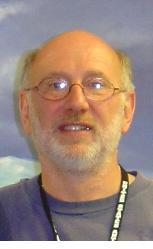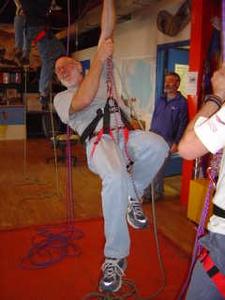
|
|
2 December, 2003
Dr. Bill Hammer, the sailing Paleontologist.
Well as you might expect I saved the best for last. I'm going to introduce you to a man who, while growing up in his native Detroit, Michigan, was more apt to be collecting model cars than dinosaurs. Little did he imagine that someday he would make a discovery of such immense importance that he would be written about in the national and world news.
When Dr. Hammer entered college the first couple of years he toyed with the idea of being a chemistry major, but he soon changed to biology (Sounds a bit familiar? Read Nate Smith, 28 November). Upon graduation, he began working on a master's degree in Zoology when he heard that Dr. John Cosgriff, needed a grad student to accompany him on a trip to Antarctica. The goal of that trip was to explore some early Triassic formations in hopes finding fossil amphibians and synapsids. In typical Hammer fashion, the then graduate student said, "Why not?" Thus began a seven-season affair with Antarctica, a serendipitous decision that would eventually lead him to fame if not fortune.
That first trip was held off for several years because at that time flying around Antarctica was not well understood, they were still trying to figure out how to keep JATO (Jet Assisted Take Off) bottles on the fuselage of the C130 Hercules, the airframe that was and is the mainstay of Antarctic travel. Finally, in 1977, he made his first trip to Antarctica, where they collected early Triassic synapsids and temnospondyl amphibians. In subsequent years they returned to some of the same areas, collecting fossil remains of Kannemyeria and Cynognathus as well as a 3 foot long skull of a Capitosaurid temnospondyl, then during the 1990-91 research season, a petrologist by the name of David Elliott, was working on Mt. Kirkpatrick, which is predominantly volcanics, consequently it was not high on the list of priorities for the paleontologists to explore. Anyway, Elliott, picked up a rock in some scree (A slope of loose rock debris at the base of a steep incline or cliff.) that was of sedimentary origin and had what appeared to contain fossil remains. He called Dr. Hammer's group on the radio and when they arrived on the scene, they began to survey the area in detail and soon recognized fossil remains of a dinosaur. That dinosaur was subsequently described in a paper by Dr. Hammer and William Hickerson in which they named it Cryolophosaurus ellioti, or the "Frozen Crested Dinosaur". They eventually collected between 120 to 140 bones and 16 teeth representing 6 different taxa (The plural for a taxonomic category or group, such as a phylum, order, family, genus, or species.) These all come from the Hanson formation on Mt. Kirkpatrick, where we are returning this year to extract more of the fossil remains.
In 1999, Dr. Hammer and his mountaineer, Dave Buchanan, hatched a plan to give them the best possible chance at returning to the site to get at the rest of Cryolophosaurus and explore other possible fossil beds. As you can imagine, mounting this sort of expedition is expensive, and the work that he needs to do can only be done by helicopter, which is a huge expense. So a remote camp must be put in to function as a base of operations to support the science. In the past, many remote camps have been large and very expensive and logistically difficult to maintain. Their camp was going to be small, where each group would share some resources, but is mobile enough to be able to get away, further a field. Hammer's plan met with approval at the NSF (National science Foundation) and soon he was planning the details for this season.
I count myself extremely fortunate to have landed with Dr Hammer, for a number of reasons. First, when you mention to someone you are going to the Beardmore Glacier, their eyes glaze over and they become very envious. To a person, they all comment that that place is the real Antarctica. Second, working on the removal of a rare and exotic fossil, life doesn't get any better. Third, to be attached to a team of world-class scientists, or as our Mountaineer, Peter Braddock puts it, "What better education could you want?" And last but certainly not least, is Bill Hammer, himself, a relaxed man, very gracious and knowledgeable. A man who is eager to share his experience and all that is Antarctica with those around him. He makes you feel instantly at ease and has put together a team that is capable of producing anything possible. When hit with the inevitable snafu, (Like a team member being scratched at the last minute.) he adapts quickly and never dwells on the setback.
Dr. Hammer reminded me the other day that the best part of this trip is yet to come. Yet as I write this, I am looking out our office window at 55 mph winds rearranging McMurdo Station. This has placed us on a weather hold and we are not sure when we will be leaving McMurdo for the Beardmore Camp. This situation brought me back to the first time I met Dr. Hammer, we were in Washington, D.C. at the NSF planning meeting. Scientists, flight managers and NSF officials were planning schedules and loads for the Beardmore Camp. I looked over at Dr. Hammer, and saw Bill silently chuckling to himself. I asked him what was so funny and he replied, "You know, this is all well and good but you might as well throw this all out, because when you get to McMurdo, the weather does all the planning for you!" Right again, Bill, right again.
Dr. Hammer is a professor at Augustana College in Rock Island, Ill. He holds the Fritiof M. Fryxell Endowed Chair there. He received his B.S., M.S., Ph.D. from Wayne State.
P.S.
I almost forgot another reason this why is a good match, Bill Hammer is a seasoned sailor as am I, so when the weather closes in at camp we can regale each other with our exaggerated sailing stories! (Our poor tent mates!)

Dr. William Hammer

Dr. Hammer practices his rope skill in the BFC

Dr. Hammer does not take himself too seriously......

Ever!
Contact the TEA in the field at
.
If you cannot connect through your browser, copy the
TEA's e-mail address in the "To:" line of
your favorite e-mail package.
|
